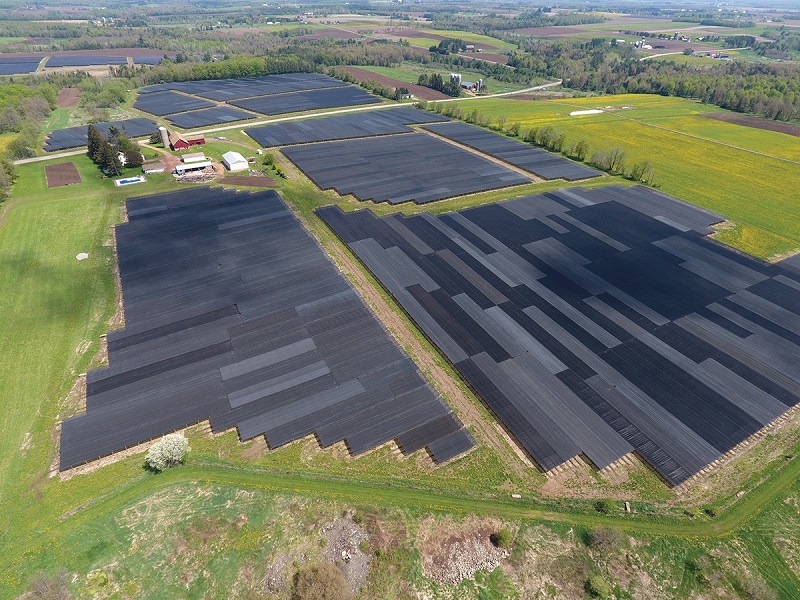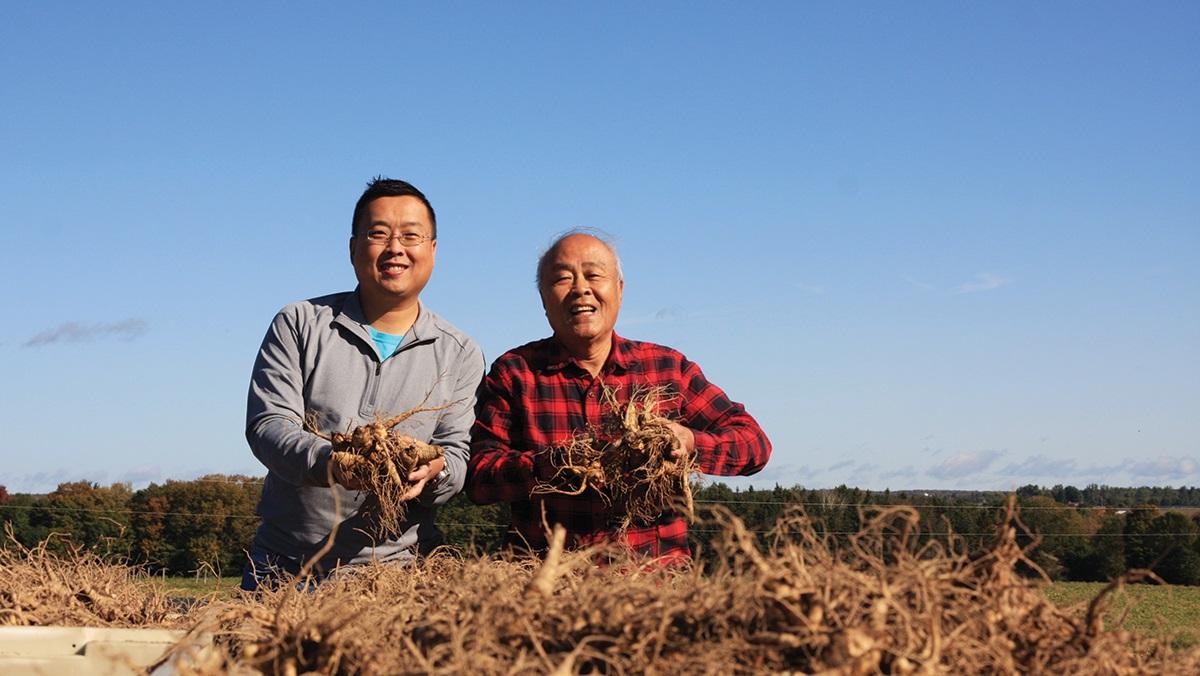A Ginseng A Day Might Keep The Doctor Away | Chef Theresa Lin’s Ginseng Chicken Soup
As I pulled into the parking lot of Hsu’s Ginseng Enterprises, Inc., in rural Marathon County, I realized that I don’t know much about ginseng. Yet in Wausau, as I will soon learn, this gnarly white-root vegetable is king.
Upon entering the Hsu corporate offices, I’m greeted by Will Hsu, the second-generation proprietor of Hsu’s Ginseng and current president of operations. “Welcome,” Will says, joining me in a conference room. The walls are covered with photos of him and his father, Paul Hsu, posing with governors and even a U.S. president. “What would you like to know about ginseng?”
A lot. And I’m particularly interested in why so many Americans are beginning to turn toward it as an herbal remedy. Ginseng is a staple in Chinese medicine and has been used for thousands of years across Asia, but its health benefits are still understudied in Western science.
Ginseng’s origin story begins an estimated 5,000 years ago, in a mountainous region of modern-day Manchuria, China, where locals first stumbled upon a gnarled root-based herb with a vaguely human shape that was believed to have medicinal properties. They harvested it, shared it with the Chinese Emperor, and the first ginseng industry was born.
Over the next several thousand years, people in China and Korea popularized ginseng, drinking it in tinctures and tea, and adding it to cuisine. Given the scarcity of wild ginseng, it was initially reserved exclusively for the elite. However, over time, the rise of cultivated ginseng provided greater access for the masses.
Paul Hsu, the founder of Hsu’s Ginseng, was born and raised in a fishing village in the Pescadores Islands in the Taiwan Strait, a hundred miles from mainland China. Growing up, Paul wasn’t especially interested in ginseng. Instead, his focus had long been on the United States, a faraway land where he believed his future might await him. Paul was born the tenth of fourteen children, and money was tight. Yet, in 1969, at age 26, Paul received a scholarship to study social work at the University of Denver, which he gladly accepted. While Paul thrived in his adopted home, his scholarship expired the following year.
Desperate to stay in the United States, Paul learned of a job working for social services in a state called Wisconsin. He moved, sight unseen, and found a job in social services in Fond du Lac. There, a colleague asked Paul if he’d ever heard of American ginseng—a milder, cooler alternative to the warmer Chinese ginseng grown overseas. Paul hadn’t, but he was curious to learn, and he read an article about a small group of Wisconsin ginseng farmers located only two hours to the north, in Marathon County. The article also noted ginseng’s wide-ranging potential medicinal benefits—from building immunity and regulating blood sugar to reducing inflammation and fighting fatigue.
Paul’s interest was piqued for personal reasons, as his mother’s health was in decline. “She just looked sickly and frail,” Will recounted the story he’d often heard from his father. “She wasn't that old, but she’d lived a tough life and there just wasn’t a lot of health care on the island.”
From 7,500 miles away, Paul felt helpless to assist. But then an idea occurred to him: What if I send some Wisconsin-grown ginseng to my mother? He did, and nine months later, he received a letter from his father.
“Son, you probably won’t believe me,” his father’s letter began. “[But] what you sent to your mom really helped save her life...”
It was all the proof Paul needed to reroute his career. From that moment on, he was in the ginseng business.
With the support of his wife, Sharon, Paul began a mail-order ginseng business, shipping American ginseng throughout the world. In 1974, he officially formed Hsu’s Ginseng Enterprises, Inc., which marked its 50th anniversary in 2024. While the mail-order ginseng business got off to a good start, Paul’s purchasing power was initially limited; he had to rely on other ginseng farmers for sales. He knew, though, that if he could cultivate his own ginseng, he could sell as much as he could grow.

Given the crop’s high economic potential, growing ginseng was a closely guarded secret among a small group of farmers. Yet after moving to Marathon County in the mid-1970s, Paul met a few farmers willing to help him, including Toby Karlen and Donnie Volhard. Under their tutelage, Paul learned the nuances of ginseng farming, from crop rotation to shade cover. Once he had the growing process figured out, all Paul was missing was a farm. There, too, was a problem: farmland wasn’t cheap.
One Sunday morning in 1977, Paul, Sharon, and their newborn son, Will, attended Wausau’s Presbyterian church. After the service, a congregant struck up a conversation with Paul. “I hear you’re starting a business,” the man said. “Do you need a loan?”
The congregant happened to be a loan officer at a local bank, and he sat down with Paul only a few days later. Paul completed the loan application and was quickly approved.
“At that time, my dad didn't have many assets,” Will continued. “He had a house with a mortgage and a car.” However, the local bankers trusted Paul’s work ethic and expertise and had the foresight to see the potential in his plan.
In the beginning, Hsu’s Enterprises, Inc. mostly operated out of the family home. As a child, Will was routinely awakened at all hours of the night to the sound of a ringing phone. The Hsus’ overseas clientele—mostly from mainland China—came with a 14-hour time difference. Yet no matter the hour, Paul or Sharon always answered the call.
To grow his stateside market, Paul began placing ads in Mandarin-language newspapers in major cities with large Chinese populations, including San Francisco, Los Angeles, and New York. “You’d just clip the ad, send the money, and tell him what you wanted,” Will recalled. He began helping his parents run the mail-order side of the business at eight years old. “I’d open these envelopes, and money would just come pouring out,” Will laughed.
And their business was only beginning.
While the history of ginseng in China spans thousands of years, here in North America, its recorded history has a far more abbreviated timeline. Some Haudenosaunee Tribes had long employed ginseng as a remedy, but the herb’s first documented “discovery” occurred in 1716 when a Jesuit priest named Joseph-François Lafitau was introduced to a unique plant along the St. Lawrence River, near Quebec, that would eventually become known as American ginseng, Panax quinquefolius.

The first successful attempt to cultivate American ginseng in Wisconsin didn’t occur until nearly two centuries later, in 1904, in the township of Hamburg just northwest of Wausau. On the advice of a neighbor, the four Fromm brothers, who ranged in age from 11 to 17, began experimenting with how to transplant wild ginseng onto their parents’ farmland. To the surprise of their parents, their work paid off. Their 1915 ginseng harvest netted the Fromm brothers $3500, over $100,000 in today’s dollars.
Following the Fromm brothers’ success, ginseng cultivation soon spread throughout central Wisconsin, with Marathon County emerging as American ginseng’s epicenter. The green, leafy plant with red flowering berries soon began popping up throughout the region. Today, the Ginseng Board of Wisconsin hails central Wisconsin as “the Napa Valley of American Ginseng,” noting that “98 percent of all U.S.-cultivated American ginseng comes from a 1,500 square mile region of central Wisconsin.” In 2017, ginseng was officially designated as Wisconsin’s state herb. That same year, Wausau began hosting the International Wisconsin Ginseng Festival.
There’s a reason for the region’s industry dominance: geographic locale. Situated on the 45th parallel, the area provides the ideal climate for ginseng: not too cold, not too hot, and a nutrient-rich sweet spot for rooted crops, including not only Wausau’s ginseng but also my beloved horseradish in Eau Claire.
Despite these near-perfect growing conditions, ginseng doesn’t make things easy on commercial cultivators like the Hsus. For starters, you can never reuse the land for a future ginseng crop when growing ginseng. The plant drops seeds that release toxins into the soil—ensuring that no other ginseng plants can grow close enough to compete for resources. This means the Hsus and other commercial growers must continually find new farmland while offloading the previously used land.
This is just the beginning of the hardships. Ginseng’s long growing cycle is equally daunting; it often takes four to five growing seasons before it can be harvested for its full profit potential.
“It’s a long wait,” Will says. “It’s always a long wait.”
A lot can go wrong over five seasons, which is the timeline the Hsus prefer for maximum yield. There is weather to consider, disease, and invasive species. There are also human-induced problems, including COVID-19, production costs, supply chains, competition, and more.
For 50 years, the Hsus have endured all these challenges, taking it mostly in stride. One year, however, stands out in the family’s memory as almost being the end of the line. Will recounted the Mother’s Day snowstorm of 2010 as exceptionally damaging to the Hsu family’s farm, as well as to the regional ginseng industry as a whole. “My parents will tell you they've never cried the way they did in 2010. My mom says the last time she remembers crying like that was when her mom passed away.” The late and unexpected snowfall piled on top of the shade fabric, causing it to collapse and smother the crop. Marathon County’s ginseng farmers saved what they could, but it wasn’t much. The results were devastating. “I mean, you look out at your crop, and you see your livelihood is at risk.”

For some of the Hsus’ peers, the snowstorm was the last straw in what has been a steady decline in the ginseng industry since the early 1990s, when nearly 1,000 Wisconsin farmers were growing the herb. Today, fewer than 100 ginseng farms remain in the state.
Will attributes the decline to farm consolidation, volatility, and commodity prices—the same scourges ravaging family dairy farms, among others. As with other farm niches, there is another struggle too: ginseng farmers’ children are more reluctant than ever to continue the family trade.
That makes Will Hsu a unique exception. After graduating from high school, Will initially left the family farm. He earned business degrees at the University of Wisconsin-Madison and Harvard Business School, and subsequently worked in the private sector for over a decade.
In 2011, Will’s career trajectory abruptly changed. As Hsu Ginseng Enterprises, Inc. struggled to regain its footing in the aftermath of the Mother’s Day snowstorm, the family was struck by a more personal setback when Paul Hsu was diagnosed with prostate cancer. “I thought I’d only come back for six months or a year while my dad was getting treatment,” Will says. “After he was back on his feet, I figured I’d go back to corporate. But I just never went back.”
For Will, dedicating his professional life to the family business was about more than a job. It was about securing a legacy. At the time, Hsu’s Ginseng Enterprises, Inc. was nearly 40 years old and had become not only a trusted brand with more than 100 employees, but also an economic driver for the Wausau community. “America was relying on us to keep this thing going,” Will says. “It just seemed sad to say that we wouldn't continue growing.”
And so, thanks to Will, Hsu’s Enterprises has continued growing, and this year, they’re on track to process 300,000 pounds of ginseng.

Despite the rise in ginseng users worldwide, the industry remains uncertain in Wisconsin. Will fears tough times may be ahead, particularly for the global market, which makes up 90 percent of their business. In Chinese medicine, Asian ginseng is considered “warm,” while American ginseng is considered “cool.” And the cool, American ginseng is the kind that Chinese users most desire—if they can afford it.
“The U.S. relationship with China is very difficult right now, and I'm not sure either side wants to repair it,” Will says. Currently, the Chinese government has placed a 25 percent tariff on imported ginseng, including the crops grown by the Hsu family. The threat of a larger trade war in the coming months, along with potentially steeper tariffs, looms large.
For ginseng farmers like Will, it’s a frustrating predicament that is beyond the family’s control. “It kind of feels like you’re going through a divorce,” Will says of the current breakdown in trade relations between China and the United States. “You have to pick a side.”
In the meantime, harvest season continues.
Upon entering the processing facility, we are overcome with the bitter scent of ginseng. Off to our right, we enter the equivalent of an enormous walk-in cooler, where crates of thousands of pounds of ginseng will cure for two to three weeks in 38-degree temperatures. Curing helps the plant to shut down, convert sugars into carbohydrates, and enhance taste. Once the curing is complete, the harvested ginseng enters a washing cycle and goes through a water spray flume before bouncing along more moving conveyors. Workers visually inspect the ginseng plants for quality and remove any inedible roots and foreign materials that have made it through the washing cycle. Next, the ginseng is placed on drying racks in 100-degree kilns, which resemble a string of storage units, to cure for two to three weeks more before packaging.
“The whole process, from digging, to curing, to washing, to drying takes almost two months,” Will says. That is, of course, in addition to the five years of growing.
“Ginseng is not that easy to grow,” Paul says. “It’s a long-term investment, and also very labor intensive, and risky as well.” It is not, by any measure, a get-rich-quick crop. “It’s a get-rich-slow crop!” he says.
And for half a century, the Hsu family has certainly invested their time in growing their unique roots in Wisconsin soil.

A Ginseng a Day
Might Keep The Doctor Away
Blame it on diet, lack of exercise, sleeplessness or stress—whatever the reason, many of us are feeling less healthy than ever. Ginseng might be able to help, according to Will Hsu.
“It works as a preventative. People take daily tonics and tonifiers to boost the body's ability to fight off disease and sickness. But it’s hard to prove,” he says. “There are not a lot of [scientific studies] out there that say, ‘If I take these things, I will do better, I will feel better, I won't get this disease.’ You can't necessarily prove that, but I think traditional Chinese medicine is more holistic. It cares more about how you feel.”
Will suggests trying ginseng via a daily cup of ginseng tea, just like the millions of Chinese consumers who swear by it. “Chinese consumers are just like any other consumer,” Will says. “They’re not going to spend hundreds of dollars on a product that doesn’t work.”
In many ways, ginseng’s potential benefits are ideally suited for the perils of Americans’ modern lifestyle. “We’re stressed,” Will says. “We’re high-strung.”
Will describes an average day in which many Americans wake up tired, drink a stimulant like coffee or an energy drink to offset their fatigue, eat highly processed foods, work too hard, rest too little, and then cap the evening with a depressant, such as beer, wine, or sleep aid.
“And then,” Will says, “we wake up and do it the exact same way again.”
Will explains that the Chinese lifestyle is different. While ginseng may not be the “cure-all” for everything that ails us, it can serve as one piece of a larger puzzle toward a healthier lifestyle, he says. “It helps your body, maybe now more than ever, given what our lifestyles have become.”
Chef Theresa Lin’s
Ginseng Chicken Soup
Hsu’s Ginseng Enterprises sponsors Theresa Lin’s cooking show on EETV, the largest Chinese television network in the United States. Lin has been dubbed “the Julia Child of Taiwan” and is the author of sixteen cookbooks.
Ingredients
2 stalks Hsu’s fresh American ginseng (or substitute same amount of dried)
1 whole free-range chicken
6 slices dried Chinese yam
3 slices ginger
10 red dates
3 tablespoons dried goji berries
2 tablespoons rice wine
1 teaspoon whole white peppercorn
Sea salt to taste
Green onion, shredded (optional)
Chop off the chicken feet and reserve them for later. Blanch the rest of the chicken in boiling water to remove the blood, about three minutes until the exterior turns white. Rinse the chicken.
Meanwhile, soak the red dates, goji berries, and yam in water for ten minutes. In a large pot, combine chicken, chicken feet, ginseng, drained red dates and yam, ginger slices, white peppercorn, and rice wine. Add enough water to cover all ingredients, then cover and bring to a boil over high heat. Once it boils, turn the heat down to medium-low and let simmer for two hours. Add goji berries. Season with sea salt, and serve hot with a garnish of green onion.
Reprinted from Smithsonian Folklife Festival.
All photos by Hsu Ginseng Enterprises




